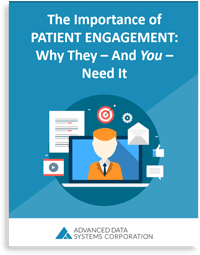Healthcare Blog
The latest in all things RCM, Electronic Health Records, Radiology Information Systems, Practice Management, Medical Billing, Value-Based Care, & Healthcare IT.

By:
Stephen O'Connor
June 22nd, 2015
By now, you have already determined that you cannot run your radiology practice to its full potential by relying only on generic medical office software solutions. You know that you need to implement dedicated radiology software in your organization. One of the biggest challenges you face at this point is simply finding the best application to meet your particular practice’s needs. Is the software scalable if you drastically increase your operations? How will a particular radiology application dovetail with your organization’s core processes? For example, your practice may have a mandate to empower patients with a patient portal. The portal will let each patient sign in with an Internet-connected computer and then check things such as the latest X-rays or other diagnostic tests. Will the radiology software you have in mind be equal to the task? Such questions are designed to help you find the best possible application for your organization. To help you with your decision making process, here are three ways to find the best radiology software.

Medical Billing / RCM | Practice Management
By:
Stephen O'Connor
June 19th, 2015
Are you on the lookout for a medical billing company? If so, you likely have a number of questions that must be satisfied before you will make your final decision. It doesn’t matter if you have been in business for some time now or are just about to launch a new practice. The medical billing company you choose to work with will figure greatly in the financial health of your practice. With that in mind, here are four features that medical billing companies should have.

Learn why patient engagement is a necessity and how you can master it within your practice.

Industry News | Healthcare Advice
By:
Advanced Data Systems Corporation
June 18th, 2015
The following excerpt if from an article found on EHR Intelligence. It ws written by Vera Gruessner. The healthcare industry is at the tipping point when it comes to the ICD-10 transition period. With only 3.5 months to go until the ICD-10 implementation deadline, various new bills have cropped up within the House of Representatives looking for either another ICD-10 delay, a complete stop to the transition, or an ICD-10 transition period called “safe harbor.”

By:
Stephen O'Connor
June 10th, 2015
These days, you would be hard pressed to find an industry that hasn’t embraced the use of computers and specialized software to streamline operations and get more work done, more efficiently. However, in such a forward-thinking industry as the medical profession, some organizations are still working with antiquated paper-based systems to manage the voluminous information they record on each patient. As a savvy medical professional yourself, you may be new to electronic health records software but are ready to learn how to use it to improve the level of care you offer patients. That’s good, because the sooner you learn about and implement EHR software at your facility, the better. Here’s what you need to know about EHR applications.

By:
Stephen O'Connor
June 8th, 2015
Unlike at a hotel, where the staff can typically count on people checking out by a specific time, hospitals, inpatient facilities and other medical organizations that have beds for patients can expect a lot more turnover and will see beds becoming available at random times of the day and night. Managing beds can be a tricky process. If you don’t use software to keep track of bed status and availability, it can cause problems where your staff faces bottlenecks in treating patients. You don’t want to keep patients and their families waiting any longer than is necessary, because delays can provoke anxiety. What’s more, if you are inefficient at managing the beds, you may find that you are not bringing in the revenue you anticipated.

By:
Stephen O'Connor
June 5th, 2015
Making a choice in specialized software, such as that used to keep track of patients’ medical information, is not something you’ll want to take lightly. Implementing a new electronic health records software solution involves an investment of your money, time and staff resources, so it only makes sense that you would take your time in determining the best application and provider to go with. If you are fortunate, some of your colleagues at other, non-competing medical practices may have some good leads for you to check out. However, the way things work at your medical organization could be quite different, so your software requirements may not dovetail with those of your colleagues.

By:
Stephen O'Connor
June 3rd, 2015
Owners and managers of bustling mental health organizations sometimes become so busy and involved in day-to-day activities that they aren’t able to budget much time to become familiar with the software systems they’ve implemented. Whether you are a newcomer to working with mental health electronic medical record applications or have had some time to integrate this type of software into your practice, there may be some features that you are still unfamiliar with. It pays, however, to learn more about your mental health EMR application so you and your team can grow proficient and better serve your patients. Here are three ways to make the most out of your mental health EMR.

Industry News | Healthcare Advice
By:
Advanced Data Systems Corporation
June 1st, 2015
The following excerpt is from our whitepaper, "Engage, Retain, & Acquire Referring Physicians: Making Yours An In-Demand Radiology Practice." For years, getting radiology reports efficiently to referring physicians had been a conundrum; none of the options were great. Yet, they were the only ones available at the time: regular or special delivery mail, courier if the recipient was local enough, perhaps leaving the report in the physician’s mailbox at the hospital, or faxing it.

Electronic Health Records | Industry News
By:
Advanced Data Systems Corporation
May 26th, 2015
The following excerpt is from an article found on EHR Intelligence. It was written by Vera Gruessner. Over the last two decades, the medical industry has changed drastically in terms of patient care and access to medical records. It was nearly impossible to obtain one’s own health record 20 years ago. Forbes reports that patients had little choice but to press legal action if they wished to access their own medical data.

Electronic Health Records | Industry News
By:
Advanced Data Systems Corporation
May 22nd, 2015
The following excerpt is from an article found on Health IT Outcomes. It was written by Katie Wike. According to a survey conducted by HIMSS in honor of Nurses Week, the majority of nurses wouldn’t go back to the way records were before EHR implementation. Nurses agree, EHRs improve patient safety and most couldn’t do their job without them. HIMSS conducted a survey of more than 600 nurses in honor of National Nurses Week.